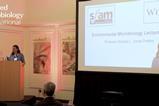CRISPR-Cas9, which is often nicknamed ‘CRISPR’, is a technique that can edit DNA. The system has two parts: an enzyme and a guide. When introduced to a cell, the enzyme (Cas9) will cut DNA in a specific location determined by the guide.
Coming from a biotechnology background, CRISPR-Cas9 has been part of my everyday vocabulary for several years now. Since it first became known to the scientific community, the question ‘Have you considered using CRISPR?’ has been a mainstay of conferences, meetings and casual conversation. It’s not just scientists who are talking about it either – the mainstream media have been talking about it for several years now as well. So, why has this technique got everyone a-buzz? We’ve been able to edit DNA for a long time, so what is it about CRISPR-Cas9 that sets it apart from everything else? This short article should shed some light on the subject.
CRISPR-Cas9, which is often nicknamed ‘CRISPR’, is a technique that can edit DNA. The system has two parts: an enzyme and a guide. When introduced to a cell, the enzyme (Cas9) will cut DNA in a specific location determined by the guide. When CRISPR-Cas9 was discovered, these guides were CRISPRs, which stands for clustered regularly interspersed short palindromic repeats. These guides are used to fight off viruses; if a virus infects a cell, CRISPRs guide Cas9 to the DNA of the virus and cut it apart, killing it.

Whilst the use of CRISPR-Cas9 by archaea and bacteria as a sort of immune system against viruses is very interesting – and there’s still lots of research being done on the subject – the real interest in CRISPR-Cas9 for most people is the fact that you can tailor the guide to any DNA sequence in any organism. This basically means you have a system with only two components that you can design to cut any sequence of DNA you might need to, and that’s what has got scientists excited.
Covering all bases
So, what’s so great about being able to cut DNA? Well, put simply, cutting is the first step to making a change. In its simplest form, using this technique to cut DNA in a cell forces the cell to try and repair the break, which often introduces errors that we call mutations. This can be very useful for research to find out what a particular piece of DNA does, as by changing the DNA sequence we can change the function of whatever it codes for. Observing these changes can improve our understanding.
Taking it a step further, imagine now that you used two guides for your Cas9. This would mean two breaks that need fixing and there’s a chance that when things are put back together, everything between the two breaks is removed. This is called a deletion and is extremely useful to us. Deleting a gene (a section of DNA that codes for a protein) can be used to better understand the gene (for example, seeing how the cell behaves without the gene and assuming that whatever has changed is related to the gene that has been deleted) but can also be used in biotechnology to delete genes that are counterproductive to whatever you want your organism to do.
For example, imagine you had a type of brewers’ yeast that made a beer with a bitter aftertaste, but otherwise was a great beer. After a bit of research, you find that the yeast is making a chemical that tastes bitter, so using CRISPR-Cas9 you cut out the part of the DNA that codes for the pathway that makes the bitter chemical. Apart from that one change, the yeast is exactly the same, so in theory you should get the same great beer but with no aftertaste. All using a simple and quick technique.
Controversy
CRISPR-Cas9 has drawn some controversy in the news and not entirely without reason. Because of its versatility, CRISPR-Cas9 can be used in all sorts of organisms – not just microbes – including humans. This can have huge benefits, such as theoretically deleting the DNA sequences that cause Huntingdon’s disease or editing pre-cancerous cells to ensure they never develop into cancer. Of course, as is often the case when DNA editing hits the mainstream media, there are always concerns about ‘how far is too far’. Is it right to edit the DNA of embryos so that they never develop disease? How about changing eye colour? These ethical questions are probably beyond the scope of this article but have prompted calls in government for the halting of CRISPR research in humans.

Source: Kieth Kissel, CC BY 2.0, via Wikimedia Commons
‘How far is too far…How about changing eye colour?’
CRISPR-Cas9 is a powerful tool for biotechnology, medicine and almost all biological research. No other DNA-editing technique is as fast and versatile or holds the potential to completely change the way we go about research.











No comments yet